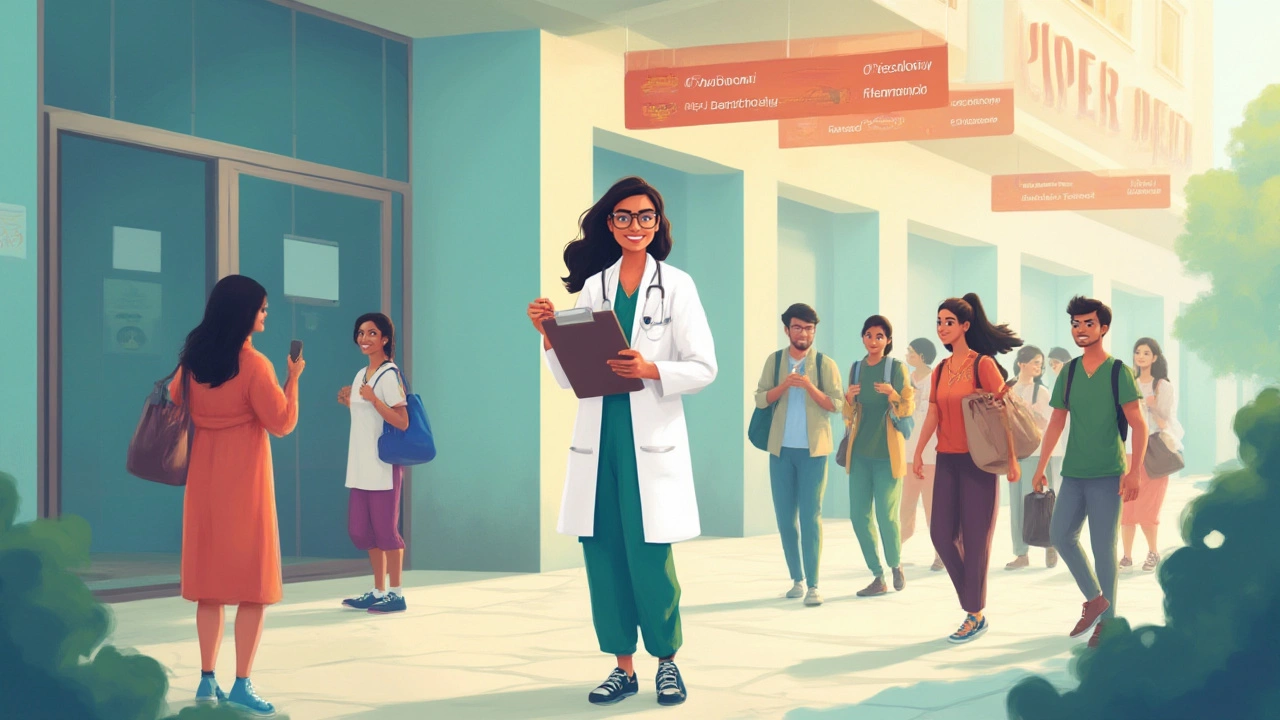Picture this: you’ve just survived NEET. It’s the middle of an August heatwave, and even my dog Bianca seems lazier than usual. But your mind’s racing between results, counseling, expectations—and that one big question: what’s the best doctor to become after NEET? India produces more than 20 lakh NEET aspirants every year, but the real chaos starts after you clear that exam. Suddenly, there’s a buffet of medical careers, colleges, and confusing acronyms staring back at you. Getting the choice right might set up your entire future—or at least decide whether your family cousin group ever forgives you at the next reunion. So, which doctor is actually best after NEET? Let’s peel back the layers.
Understanding Medical Course Options After NEET
If someone told you that every topper in your city will pick MBBS, they aren’t lying. MBBS (Bachelor of Medicine, Bachelor of Surgery) is still the most sought-after program. Every year, around 1 lakh MBBS seats open up across India versus fewer than 28,000 for BDS (Bachelor of Dental Surgery). The competition is fierce—not just for a seat, but for a spot in a top college that won’t have you spending half your stipend on hosteller food disasters or AC failures.
Here’s something interesting: NEET is your ticket not just to MBBS and BDS but a stack of allied courses. Ayurveda (BAMS), Homeopathy (BHMS), Unani (BUMS), and Veterinary Science (BVSc & AH) are also on the menu if biology is your jam. In fact, in states like Maharashtra and Tamil Nadu, BAMS seats run out just after MBBS because of high demand, especially with the revival of Ayurveda and wellness tourism in India. BDS is popular in metro cities where private dental clinics can make decent money, and everyone wants a celebrity smile (or at least healthier wisdom teeth).
Yet, here’s a sneaky fact: inpatient admission rates for Ayurveda and Homoeopathy have been quietly rising, thanks to government promotions and insurance support. Medical Laboratory Technology (BMLT) and Physiotherapy (BPT) are getting their own spotlight—these specialists are now as essential in multi-specialty hospitals as cricket in Indian monsoons. If the mainstream MBBS/BDS feels overcrowded or your NEET score is tight, these alternatives aren’t consolation prizes anymore. They’re smart, stable, and pay better than some entry-level IT jobs!
Let’s give you some data to digest:
| Course | Seats (2024-25) | Typical Duration |
|---|---|---|
| MBBS | ~1,08,000 | 5.5 Years |
| BDS | ~28,000 | 5 Years |
| BAMS | ~54,000 | 5.5 Years |
| BHMS | ~20,000 | 5.5 Years |
| BPT | ~5,500 | 4.5 Years |
Each option has a unique road ahead—different experiences, patient types, pay, and even hostel memes. Don’t just chase what the crowd yells for; listen to your calling and your scorecard’s hint.
Specializations: What Kind of Doctor Should You Become?
You’ve probably heard (from way too many neighbors) that being a doctor means endless books and round-the-clock shifts. But after graduation, the magic’s in picking the right specialization—or as my friend jokes, picking your future headaches. Specializations define not just what you’ll treat, but how much you’ll earn and how crazy your schedule will be. For example, surgeons dominate headlines but often trade off any hope of regular Sunday brunches. Dermatologists are in high demand—not only for acne teens but for the booming skincare industry, and say what you want, most don’t lose sleep over emergencies.
If you walk around a major hospital, you’ll see distinct personalities for each branch. Pediatricians have the patience of mountain monks, often dealing with ping-ponging toddlers. Psychiatrists are gaining respect, especially in post-pandemic India where mental health is finally (thankfully) being talked about. Radiologists enjoy a mix of tech and medicine with some of the highest-paying private gigs, especially if you master new imaging tech. And if you’re thinking money: orthopedists, cardiologists, and neurologists lead the chart, especially if you’re open to setting up a private practice or working abroad.
There’s also a rising need for family physicians or general practitioners. Don’t underestimate this classic role; a 2023 report showed family doctors can make up to ₹15 lakh a year in medium towns where specialist clinics are rare. And India needs GPs. We’re still short by nearly 6 lakh doctors, especially in rural and semi-urban belts—a number that hasn’t really improved since the last five years. This means job security and respect, if you’re up for travel or outreach med camps.
- Surgeon (General or specialty)
- Pediatrician
- Dermatologist
- Psychiatrist
- Radiologist
- Cardiologist
- Ophthalmologist (Eye specialist)
- Orthopedic Surgeon
- General Physician (GP/Family Doctor)
MD/MS seats? They’re limited, and the PG entrance exams (like NEET-PG) will stretch your nerves. So, plan for your desired specialty early. Graduation isn’t the finish line—think of it as BCCI selection camp; you train for your specialty before you get to play the real match. Smart students shadow seniors and try out postings in multiple departments to feel out the real-life routine—and only then lock in what they’d truly love to do forever.

What To Consider When Choosing Your Doctor Path
So, what should you prioritize? Prestige, paycheck, or purpose? Honestly, thinking about salary is not a sin, especially when you see the education loans and cutthroat competition ahead. Yet, there’s more to it: job satisfaction, impact, location flexibility, and your skills. Introverts often thrive in pathology or radiology, where patient interaction is less. Extroverts? Pediatrics or general medicine could be a fit. If you love puzzles and don’t mind tension, surgery might be your scene.
- Job demand: India’s healthcare system is evolving fast. Demand for dermatologists and psychiatrists is growing in cities, while high-quality GPs are forever in short supply in rural areas.
- Income potential: Super-specialists in cities can earn ₹2-4 lakh/month with five years’ experience. Family doctors in tier-2 towns average ₹80,000-1 lakh/month. Private practice wins if you’ve got a business streak.
- Personal interest: Never let parental or peer pressure force you into a specialty. Half of all doctors switch or regret their first choices, according to a 2021 MCI survey.
- Work-life balance: Many doctors mention burnout as a real issue. Certain branches—like radiology or dermatology—let you control your hours better.
- Future scope: AI and robotics are reshaping roles, especially in diagnosis-heavy fields. Radiology, pathology, and even surgery will look very different by the time you finish specialization.
Here’s another cool tip: international exposure matters. Many who clear NEET later give USMLE (for USA) or PLAB (for UK) to work abroad. Foreign countries often pay 3-5x more than private clinics here, but the exams are tough, and the process is long. English fluency and practical skills are a must.
Never pick purely by college ‘brand’ either. Even mid-range colleges have superstar mentors and strong alumni networks. Dig up pass rates, patient load at attached hospitals, and how many graduates actually make it to top PG courses or set up clinics.
And don’t forget happiness. My friend Neha dumped her BDS seat after a year and switched to physiotherapy—she now loves working with sports teams and skips nine-to-five monotony. Your dream job is about what energizes you, not just what your NEET rank delivers. Sometimes, changing tracks is the brave, smart thing to do.
Insider Tips and Pathways for Future Doctors
If you’re stressing about picking the “right” doctor role, relax—there isn’t one perfect road. Instead, try these hacks to level up your decision:
- Experience matters: During internships, volunteer for camps, or shadow different departments to actually see what specialists do daily. The day-to-day grind can surprise you compared to textbooks.
- Online communities: Use LinkedIn, Quora, and even Insta to connect with young doctors. They openly share campus realities, exam tips, and job market secrets.
- Back-up plans count: Always shortlist 2–3 pathways—MBBS, BDS, and one allied course matching your NEET score. Counseling rounds can be unpredictable, and sometimes the ‘Plan B’ surprises you in a good way.
- PG prep starts early: If you want high-in-demand branches like Dermatology or Radiology, start PG exam prep during undergrad. Mock tests help, but talking to toppers gives you shortcuts you won’t find in guides.
- Networking: MCI conferences, webinars, and even hospital alumni meets often connect you to internship and residency openings you’ll never see listed outside. Early networking is like compounding savings: the sooner, the better.
Job stats say by 2030, India needs over 25 lakh new health professionals, not just MBBS doctors. So, anyone who’s committed, skilled, and open to new-age medicine will always be in demand. Whether you land in a city hospital or run wellness clinics in Goa, your journey is about passion and persistence. Plus, don’t underestimate the power of a dog like Bianca—plenty of top doctors credit their pets for stress relief in crazy times.
So, which doctor is “best” after NEET? The one you truly want to become. The one where your effort, empathy, and patient success stories mean something personal. That’s your perfect med journey. And if you’re still not sure, trust me—you’re not alone. Every future doc has faced the same crossroads. So take a breath (maybe pet your own Bianca if you have one) and step forward with guts and curiosity.




